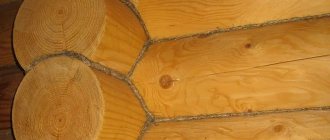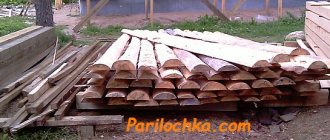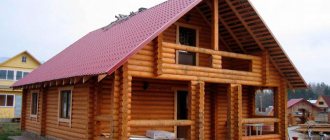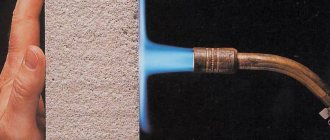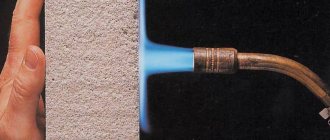Published: 07/22/2020 Category: Materials and technologies Views: 416
A modern bathhouse is often hidden in the depths of a modern high-tech house. And yet, even in the 21st century, with its nanotechnologies and composite materials, it is difficult to imagine that it occurred to someone to decorate a steam room with something other than wood. With the help of experts from the Leroy Merlin School of Repair, we understand how wood remains relevant in modern interior design, and choose the material for the walls, floor and ceiling of the bathhouse.
Why wood?
The popularity of wood as a finishing material for a bathhouse has three important practical reasons. Timber is harvested and processed in many regions of our country. Lumber production is no less widespread. The prevalence and ability to regenerate forests makes wood one of the most affordable building materials.
In addition, wood is valued for its minimal impact on human health. Low toxicity, hypoallergenicity, healing properties - these qualities of wood are widely known outside the construction industry, for example in pharmacology.
To this should be added the energy efficiency of wood, the absence of burns upon contact with skin and the ability of some species to resist the harmful effects of moisture for a long time without loss.
Thanks to this unique set of characteristics, wood has been a priority material for building baths since ancient times. In the modern world, little has changed - the only exception is, perhaps, the washing department, where water is often poured. In this room, ceramics compete with wood - in the form of tiles or mosaics. However, in a steam room, especially in a Russian bath, high temperature is added to a large amount of moisture, and wood has no competitors in the decoration of this room.
Which one is better to make floors from?
It is best to make the floors in the bathhouse from larch wood. This is the best option, because the temperature near the floor is always low, so there is no risk of resin release there. And if water pours onto the floor, then larch will withstand such an attack better than other species. However, this does not eliminate the need for thoroughly drying the bath. Because larch (and many other species) behaves well with constant contact with water, but water-air is still fraught with decay for it.
BY THE WAY! It is not necessary to make the floors of the entire bathhouse from expensive larch; you can limit yourself to only the steam room and washing room.
In other rooms, much less moisture gets on the floor and you can use a standard floorboard, for example, spruce or pine . See also the article: What is the best material to make a steam room floor from: tips, instructions, diagrams and videos.
We select finishing materials for different surfaces
In the bathhouse, wood is used to finish the floor, walls and ceiling. Different lumber is used for each surface. The floor is finished with a well-planed and sanded board, on which you can walk barefoot without fear. In the washing department, the boards are laid with a gap in order to obtain a so-called pouring floor, through which water freely drains into the sewer.
For finishing the ceiling, lining is most often chosen. The choice is due to the low weight of this lumber. Often walls are also finished with clapboard, but in this case there is a choice: the clapboard can be replaced with a board or plank.
Planken is a type of board that has undergone pre-treatment. Planken is thinner and lighter than a regular board. On the market you can find materials with a thickness of 1 to 2 cm, a width of 7 to 14 cm and a length of up to 6 meters.
During the production process, planks are profiled and the boards are given a special shape. For example, there is a planken version with sides beveled at an angle of about 45 degrees. This makes it possible to join boards with a barely noticeable seam. Planken with a lock allows you to create a flat surface on which the junction of individual boards can only be seen from a very close distance. Straight plank with sides cut at an angle of 90 degrees and rounded edges is an excellent option for finishing shelves in a steam room.
Windows in the bathhouse
The function of a window in a bathhouse is to illuminate the shelves. But since electricity does this perfectly well, the window, rather as a necessary architectural element, should be small to better retain heat in the bathhouse. For this purpose, you can install double or triple glazed windows, order an accurate PVC or wood profile. Separate bindings also increase thermal insulation. To do this, they are carefully covered, lined with polyurethane foam or plastic film, which is attached to the internal frame. The film, rolled into a tube, forms an air channel, which increases thermal insulation.
If the shape of the window is rectangular, then it should be placed horizontally and strive for a lower placement, where there is less bath steam.
After installing the window, all gaps must be sealed. To do this, dilute crushed chalk and wallpaper glue to a paste. The same putty can be used to seal newly appeared cracks and gaps.
A good historical design for thermal protection is external shutters. In addition to their protective function, carved or painted shutters will add a beautiful ethnic flavor.
How to choose a wood type
Bath culture is one of the most developed in private households. Traditions that have developed over centuries in different countries have identified the “ideal” wood for finishing. Russian bath culture has its own affordable favorites. In our country, bathhouses have been built for centuries from aspen logs, which have an outstanding ability to withstand moisture. Our ancestors valued larch and linden for their durability and memorable aroma.
These breeds have not lost their relevance in our time. Common and affordable aspen has a number of properties that make it almost the best choice for finishing a steam room. This type of wood almost does not absorb moisture and does not crack when dry. In terms of abrasion resistance, aspen lining or plank can compete with larch or oak boards. Aspen wood has good energy efficiency, and the surface of the board does not burn the skin even at the highest moments of heat in the steam room. Aspen is also valued for its healing properties, and today this is confirmed by data obtained by pharmacologists using aspen to create medicines.
The advantage of larch is its strength due to its high density. Larch boards are more difficult to process than coniferous wood, but they are just as difficult to damage. The high content of gum in larch wood makes it similar in properties to aspen: the material almost does not absorb moisture and does not rot. For this reason, larch boards will be an excellent choice for arranging a poured floor.
Coniferous lining and boards are suitable for finishing a dining room or recreation room, but they are not recommended for use on walls and especially ceilings in a steam room. The point is high resin content. For example, pine has an estimated resin content of 10–15%, while aspen wood contains only 1.8% resin. The heat causes the resin to become liquid and flow down the walls. The strong smell of spruce and pine resin can aggravate allergies. The loose wood of spruce and pine quickly absorbs moisture, so a floor finished with coniferous boards would have to be dried every time. Due to the same property, loose pine and spruce wood is more susceptible to rotting. This is especially true for low-quality wood. However, it is not difficult to avoid this if you buy lumber with a transparent history at a construction yard - a designated area for the sale of large goods on the territory of a construction hypermarket.
Modern technologies make it possible to overcome the inherent disadvantages of coniferous wood. The material under the general name “thermal needles” is devoid of them. The material is obtained from ordinary wood, such as pine, which is then heat treated, and in some cases combined with impregnation with hot oil. After drying in the chamber, pine wood loses some of its moisture, retaining only about 5% moisture. After treatment, the material ceases to be a medium suitable for the reproduction of most microorganisms that attack conifers. Impregnation prevents moisture absorption during operation.
Video description
The technology of manual cutting and how much a cedar bathhouse costs, see the following video:
Aerated concrete
When the question arises of which blocks are best to build a bathhouse from, many people prefer aerated concrete. Aerated concrete blocks are made from cement, quartz sand and foaming agents. The products are processed in a special way, which provides them with high strength.
The advantages of using such material include:
- Fire resistance. This is an extremely important criterion for the material on which the sauna will be built.
- Excellent strength, which only grows over time.
- Light weight. This nuance simplifies construction and allows you to abandon the foundation.
- Ease of processing. The material is easy to cut and drill.
Bathhouse made of aerated concrete Source sibpodryad24.ru
The main disadvantages include the rather high price and the ability to absorb and store moisture. So before using aerated concrete for a bathhouse, it is treated with special solutions. Also, when constructing a building, you will need to take additional care to create vapor insulation.
Another distinctive feature of aerated concrete is its installation with a special glue, which is used as a replacement for the cement composition. It is better not to use cement, as the blocks will absorb moisture from it, which will lead to a decrease in thermal insulation.
Expanded clay concrete
This product is a material based on cement, expanded clay, foamed and fired clay. The advantages of this choice include non-toxicity, poor moisture absorption and low thermal conductivity. Also, these structures are light in weight, which will allow you to eliminate the need for a base and save a lot of money. A bathhouse based on such material requires a small amount of insulation. Expanded clay's resistance to low temperatures is 5 times greater than that of aerated blocks, which ensures a long service life. Another significant advantage is the absence of shrinkage after construction.
Bathhouse made of expanded clay concrete Source vbanepar.ru
The thermal conductivity of such a material may vary depending on the grain size of the filler. This indicator can vary from 0.15 to 0.45. The larger the grain, the lower the level of thermal conductivity and density. For the installation of such blocks, a regular mortar based on cement and sand or special adhesives are suitable. When building a bathhouse, insulation will need to be carried out indoors. Basalt wool or layers of foil are suitable for this.
Brick
This material has the following undeniable advantages:
- Long service life. Brick baths can last more than 100 years, while the service life of wooden buildings does not exceed 20 years.
- Attractiveness. The brick will not need to be treated with any decorative solutions. It is suitable for creating any design structures.
- Fire resistance. Unlike wood, brick is not affected by fire.
Brick bath Source daglse.ru
Additional processing
For additional protection, special antiseptics have been developed for baths and saunas. Their fundamental difference is that the components protect wood for as long as possible under conditions of high humidity and temperature, while not emitting substances harmful to humans. Antiseptics differ in areas of application. For areas that come into contact with human skin, such as shelves, products containing paraffin oil or wax should be used. They penetrate deeply into the structure of the tree, protecting it from the inside. In this case, no film is formed on the surface, which means there is no risk of burns. Such formulations should not contain biocides.
The floor in the bathhouse is the most vulnerable place, which most often comes into contact with water. A special floor oil is recommended for this. The remaining surfaces can be coated with wall varnish. It forms a thin film on the surface, protecting against moisture penetration. Varnishes for baths and saunas must contain an anti-mold component, as, for example, in the varnish for saunas and baths LUXENS. They can cover walls, ceilings, doors and partitions. The high-temperature microwax in its composition protects the wood from moisture. The semi-matte film created on the surface has dirt- and water-repellent properties and can be tinted in any shade.
These articles may also be of interest to you:
- Impregnated wood: modern technologies in the country
- How to age wood - use brushing
- Several options for finishing the facade of the house
- Facade finishing materials
Installation
A steam room covered with clapboard is beautiful, fast and inexpensive. This material provides a locking system (tenon and groove), thanks to which it will be possible to assemble all the parts in a short time, while the gaps will be minimal. The lining is attached to a wooden sheathing using self-tapping screws, nails or clamps.
In what sequence is the lining of a steam room in a bathhouse performed:
- Lathing. Non-planed boards and slabs are suitable for its installation. The sheathing will not be visible. The selected material is attached to the wall perpendicular to the direction of the lining (steps from 50 to 60 centimeters). The sheathing is fastened to a wall made of brick, concrete or stone using screws with plastic dowels, and to wooden walls - with galvanized self-tapping screws.
- Insulation . The optimal material for this would be basalt wool. Plates of wool are placed between the beams of the sheathing. It is necessary to ensure that no gaps are formed, otherwise the bath will not retain heat well.
- Vapor barrier . Its task is to prevent the accumulation of moisture in the insulation and reduce thermal conductivity. At this stage, strips of glassine or other material for vapor barrier are attached horizontally over the sheathing with insulation using a furniture stapler (from bottom to top). In this case, each subsequent strip should overlap (about 5 centimeters) with the previous one. All strips must be glued using adhesive tape or wide tape.
- Installation of lining . It is better to start attaching it from the most inaccessible corner.
Installation of the lining can be carried out in two ways:
- Vertical.
- Horizontally.
In the case of vertical fastening, you may encounter the appearance of fungus. It can be triggered by the fact that the board is heated unevenly. The temperature is higher at the top and lower at the bottom. In addition, the lower part suffers more from humidity.
Despite the above disadvantages, there is also a relative advantage - a low risk of gaps. The reason for this is the uniform deformation of all boards.
With horizontal installation, the risk of deformation of the lining is significantly lower. This is due to the fact that each board is located in a certain temperature zone. When installed horizontally, the upper boards experience greater shrinkage than the lower ones. This can lead to seams coming apart.
What won't work
No matter how high-quality and correct from the point of view of work technology your finishing is, the following materials are completely unsuitable for steam rooms and bath rooms:
- Linoleum covering;
- Plastics;
- Pine boards;
- Wood slabs.
The listed types of materials are characterized by insufficient resistance to high temperatures, and plastic and linoleum will even emit harmful substances. Pine is characterized by increased release of resins.
Ceiling insulation
Insulating the ceiling in a steam room usually requires much more materials than insulating walls or ceilings. This is explained by the fact that steam, by its nature, rises very quickly to the ceiling and, in order to avoid its cooling, sufficient attention should be paid to the thermal insulation of the ceiling. The step-by-step instructions are as follows:
- We cover the ceiling of our steam room with special overlapping roll paper;
Insulation of the ceiling of a steam room - We fasten it with a wooden beam, between which the insulation will be fixed;
- Using foil and adhesive tape with the addition of aluminum, we process all parts of the ceiling so as to remove excess gaps;
- We fix thin blocks on top of the foil layer to create air exchange;
- Finally, we carry out decorative work.
Wall insulation
Step-by-step instruction:
- We attach the foil to the walls using a 40 mm horizontal beam;
- We place a sealant between them (penotherm is suitable);
- We stretch a layer of foil over everything we have. A construction stapler is suitable for fixing it;
- Using aluminum tape, we isolate the existing joints;
- Then we attach the blocks vertically;
- We begin facing work.
We talked earlier about how to carry out decorative finishing and what materials are suitable for this.


